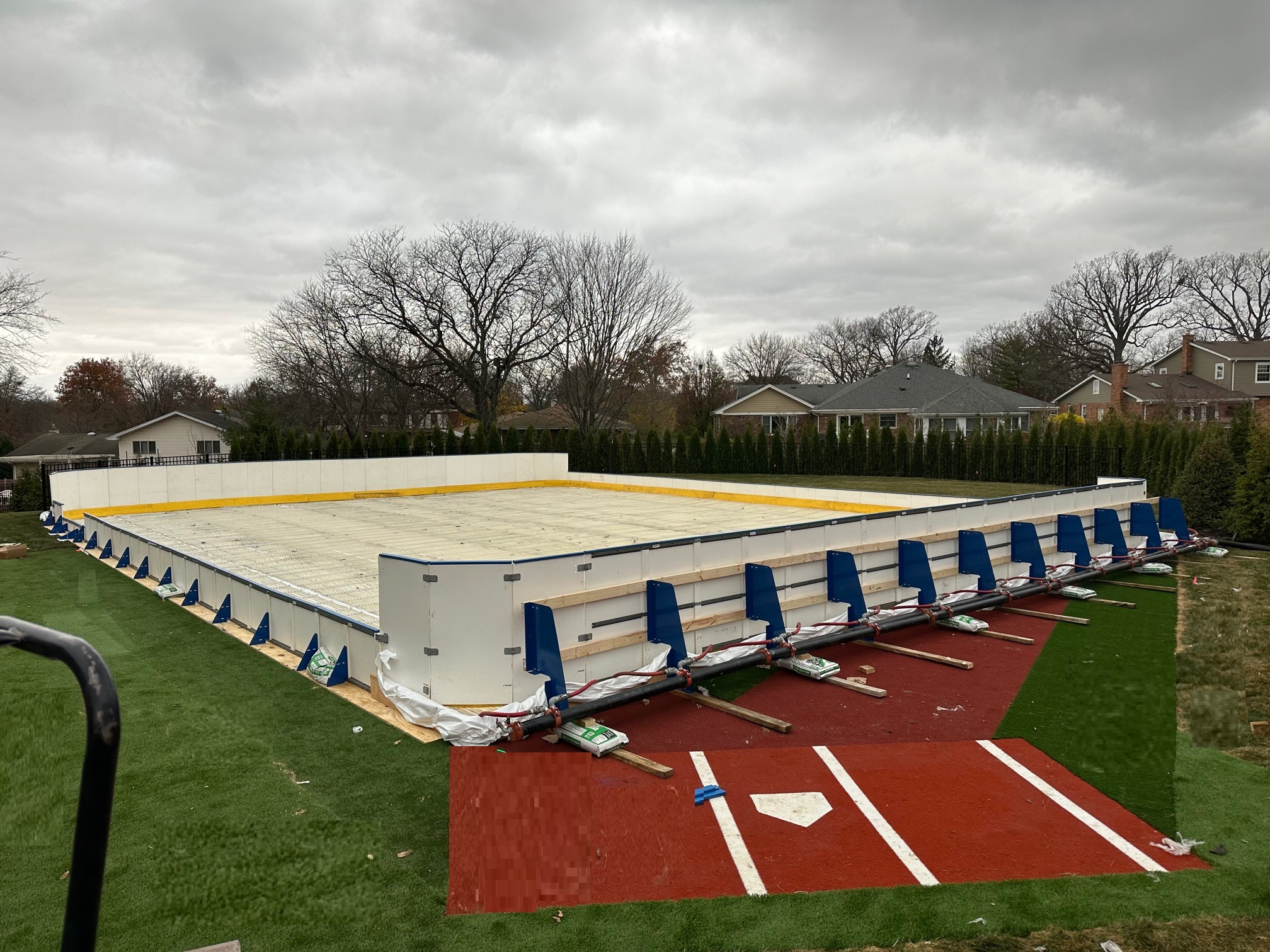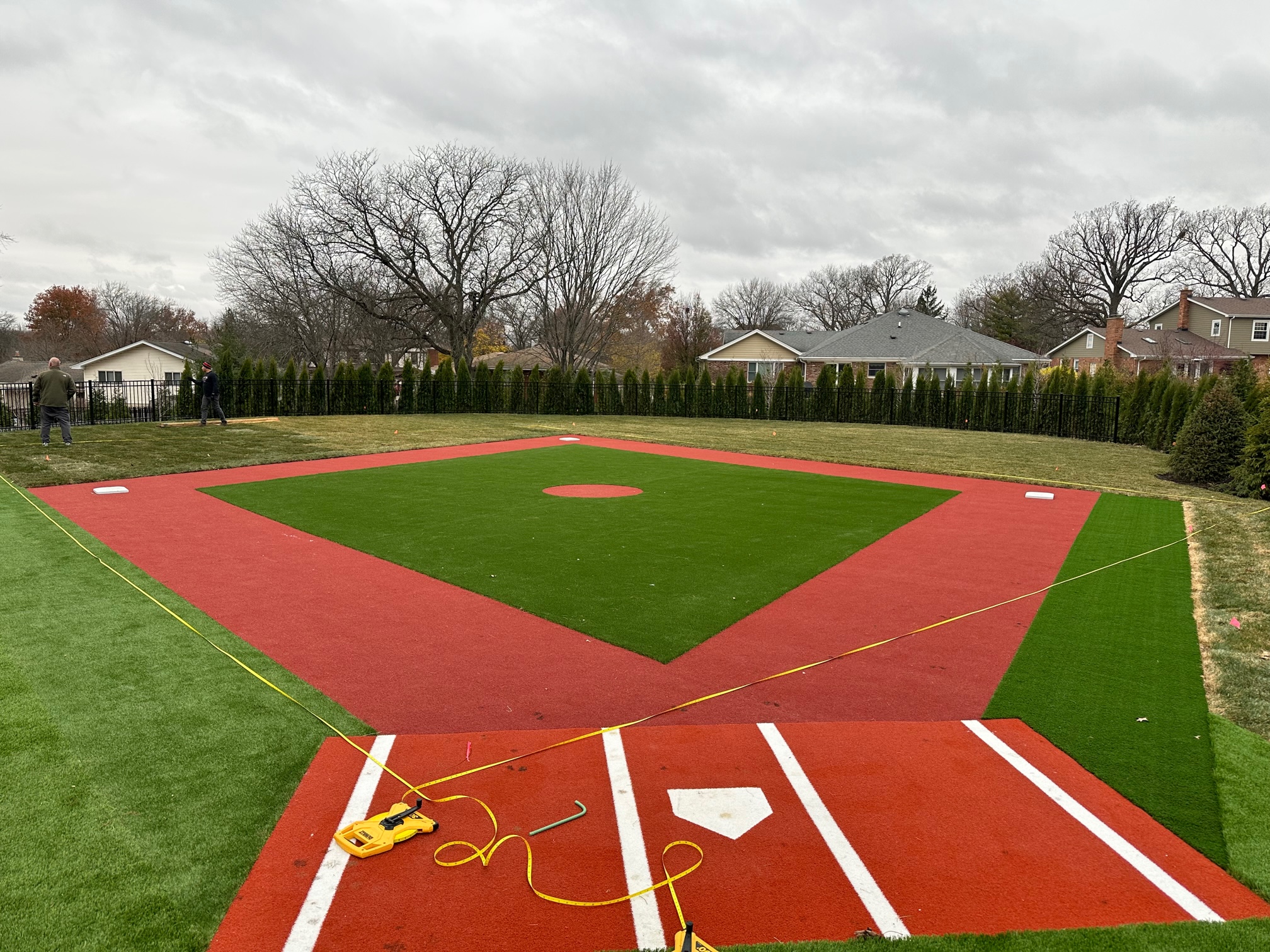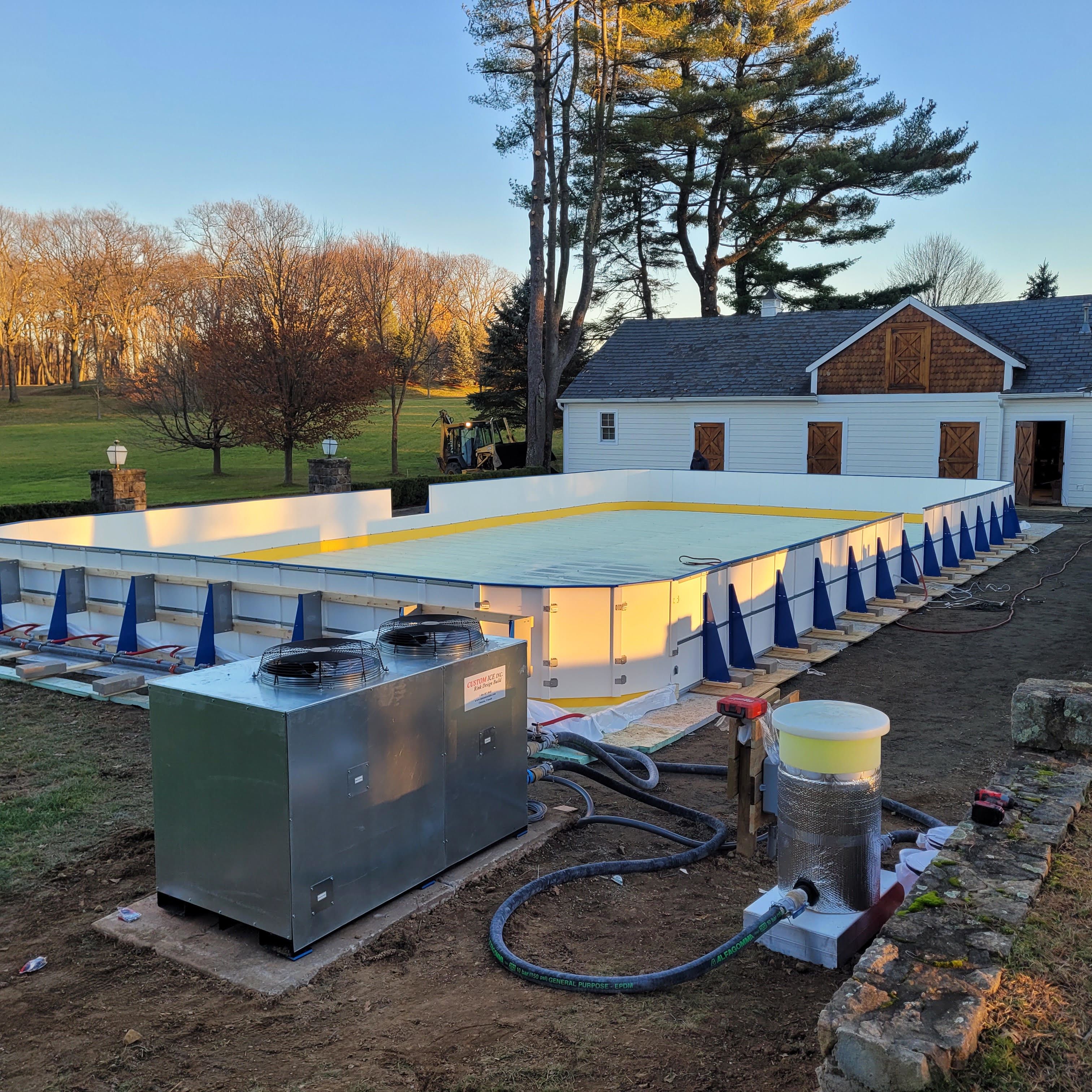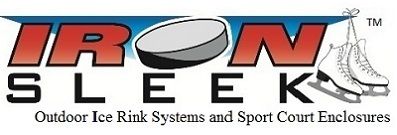FAQs for Refrigerated Ice Rinks with Chillers
Does My Yard Have To Be Level?
- The goal is to get your rink area level within 1”. The good news is with some planning there are many ways to get this done. Usually, the lowest cost method to create a level is by excavation.
- Excavation: the process of moving dirt with a skid steer.
- If you cannot excavate and the unlikeliness is under 5”, hard board foam insulation can be used to make the surface level. Insulation is light weight and easier to handle for a DIY.
- Parks and Municipalities that have access to dirt or crushed rock have built level sand boxes to get a level surface. This works great for locations that have access to raw materials and equipment.
- The final way to obtain a level surface is by decking and platforming. This method requires lots of construction materials and skilled labor.
- The ice rink mats (roll up tubing) are at the bottom of the rink on the liner. Slope will require a larger volume of ice to freeze and will take away from the overall capacity of the chiller. Basically, thick ice is not good for refrigeration.
- Here is a YouTube Video to Help Explain.
Where To Put The Rink?
- Sport pads and tennis courts are a great spot to put a chilled ice rink. They are usually closer to level than other ungraded areas and could be modified easily with foam boards. They also usually have lighting already set up. The negative is that skates can damage the court surface, so it is recommended to put rubber mats around the rink with tennis surfaces. Choose a spot where you can get level. It would be convenient to have a water spicket nearby for maintenance.
What Surfaces Are Suitable For Building A Refrigerated Rink?
- Most hard surfaces are suitable for building a rink. One of the most common surfaces that has been coming up is turf. We have installed rinks on turf. We have installed many rinks on turf and it is a great surface for building rinks. Gravel and sand are suitable as long as they are level, because we can freeze the boards that make gravel, sand, and asphalt all suitable. Lawn and grass is excellence as we can easily spike the boards into the ground usually the grass comes back healthy but we are not grass experts, so no guarantee.
- Marist High School Ice Rink Built on Turf
- As a rule of thumb divide by 10, a 2000 sq ft rink needs 200 sq ft which is basically a 10' x 20' spot with a reference point being that it is the size of a parking spot. If you are able to use racking you can condense it into half of the space.
- Chiller placement is a combination of concealment for aesthetics, placement for ease of setting up electric, distance to rink (shorter is better max 60 feet depending on sweet spot is 20 feet). Also, the chiller must have 3 feet of clearance for serviceability and air cooling. The chiller should also be approximately at the same elevation as the rink. The Maximum difference in elevation is 12 inches.
- Provided you have a solid concrete or paver collar around your inground pool, this is a possibility. We do not recommend this but if it is the only available space, it may be something to consider. Below you can check out our blog that talks about putting chillers over a pool and a example of a chiller that we installed over a pool.
- Chiller Over A Pool Blog
- Example of our Columbus Rink that is Over a Pool.
- The noise level is similar to that of a central AC Unit. Just like a central air unit is strategically place, so should the chiller to make sure noise levels are where they are desired.
- Most of our systems are a combo of:
- 2000 ft2 Chiller requires, 208-240 VAC, Phase 1, 100 amp, plus ground wire (no common)
- 1300 ft2 Chiller requires, 208-240 VAC, Phase 1, 80 amp, plus ground wire (no common)
- Here Is A YouTube Video Explaining This
- Here Is A YouTube Slide Show Of Some Examples
- Most light commercial and residential locations do not have 3 phase power. However, 3 phase power units are available upon request and can be delivered.
- Here Is A YouTube Video Explaining and Showing Phase 1 Power
- Please pay close attention to this when shopping for a chiller. Not all tonnage ratings are the same. Basically a 10-ton chiller from one company may only be a 7 ton from another. It is critical to cross check the tonnage with the compressor horsepower ratings as well. The question is: What is the tonnage for the temperature of your application? That is the info you need to be considered and compared when shopping for a chiller.
- In addition, “NOT ALL CHILLERS ARE EQUAL”. Chillers are designed according to the application. Pump sizing, freon temperatures, evaporator sizing, condenser sizing, and evaporator performance all figure into a very complex equation that determines the design of a chiller for your specific application. Iron Sleek uniquely sells Ice Rink Chillers designed for ambient conditions. If you choose to go elsewhere at a minimum, be sure that you verify the working temperatures when evaluating a chiller. For example, a process chiller runs at 40 degrees F while a brewery chiller optimum temperature is around 30 degrees F. These are not good for an ice rink application. An ice rink chiller has an optimal glycol temp of 20-degree F and should be able to reach down to 10-degree F to freeze water while the chiller itself is in the ambient vs a controlled environment.
- Do not be fooled by the low price that you may find on the internet. There is a lot of misleading information on the web. Some chillers on the internet are not even suitable for outdoor ambient temps meaning that they need to be in a conditioned room. Tonnage must be minimally validated with ambient temperature and cross checked with compressor horsepower.
- Final warning spare parts must be readily available and the Freon legal in the United States, be careful of Chinese knock-offs , we have been there before it is a nightmare.
- Most of our customers keep their chiller in place just like a central air system for their home, with some usually concealing it with decorative landscaping or customers who have pools put it by their pool mechanicals. However, some customers do decide to haul their chiller away for the summer. One of our standard modular chillers weighs 1,100 pounds and can be moved with a pallet jack and hauled away with a rental truck that has a lift gate or that has enough capacity. You can also move it with a skid steer.
- Most HVAC contractors can repair chillers. We would recommend that you contact a vendor that specializes in commercial repairs. When you purchase from Iron Sleek, we are your lifetime consultant for repairs and spare parts. We would recommend that you contact a vendor that specializes in commercial repairs. When you purchase from Iron Sleek we are your life time consultant for repairs and spare parts.
- Our chillers have spare parts that are usually locally readily available. Iron Sleek stocks main components such as pumps, compressors, thermostats and capacitors. They are ready on demand.
- Click Here For Spare Parts
- There is much to consider for tubing. Tube spacing and coolant flow are all part of the equation. Please do not wing this. Ice Tubing from Iron Sleek is specified per rink for optimal chilling and ease of use. Ice rink freeze tubes (Ice Rink Mats) are manageable 4 foot sections with quick connection to the header pipes.
- Here Are Some Examples On Our Website.
- Every job needs a custom quote but say $30USD per square foot. i.e. 30 by 60 rink costs $54k. Forgive me in advance as this is published in 2023. There is an opportunity for savings. It's important that you contact us. Every job requires a custom quote. There can be opportunities for savings.
- Check out our Rink Builder For More Pricing Information
- Here Are Some Affordable Examples
- We have found the average to be $0.30 per square foot per month. For example, a 30 by 60 rink would cost 1800ft2*$0.30=$540 per month. This is obviously an estimate because the cost of electricity varies across the US. The more precise way to calculate is to utilize the local Cost/KWh making an assumption of running time, say 50% run time.
- We have been taught that the pump is like a heartbeat for a chiller. That being said, it is a bad idea to turn off a pump that is part of a chiller in the bitter ambient. Here are some reasons not to turn off the pump. The main components of a chiller are the compressors and the pump. The compressors have crankcase heaters for when they are idle. A pump does not, when you are coming back from a deep cold it has no heat assist, you can run into a problem when it starts back up cold. Also keep in mind that a moving fluid has a much lower freezing point than an idle fluid i.e. a pond or river. Frozen antifreeze can be disastrous! In addition, for an outdoor rink, continuous flow of glycol makes for better ice as it will keep the rink more homogenous i.e. you will not have as many hot or cold spots due to sunlight. In summary it is better for the machine and better for the ice to not turn off the pump.
- There is no guarantee that a chiller will not need service through the duration of its lifetime. However, we have seen chillers that are over 15 years old still running.
- Many factors play a role in this:
- 1)Depends on the age of the chiller?
- 2) Where is it located?
- I have seen used systems sell for up to 50 or 60% of the equipment purchase value. I have also seen some sell for 25% purchase value or less. There is a used market for chiller system rinks that are in good condition.
- This depends on your climate, shading, and insulation. Chicago, Buffalo, NY, usually from Late November to Early March. Minnesota, Mid November to late March. St. Louis from December to Mid-February.
- Iron Sleek systems are modular so in most circumstances rinks can easily be expanded. We recommend starting within your budget and then growing into the rink that you would need into the future.
- 50% of our customers install solo after the 1st year. The majority of our commercial and municipality customers install solo after year 1 of having us do the initial installation. Obviously, smaller rinks are easier to install. i.e., a 24 by 50 is very manageable. Install prices range from between $3,500 to $9,000 depending on size and location. Here are two YouTube videos to help explain this.
- St. Louis DIY Refrigerated Rink Customer Testimonial
- Boston DIY Refrigerated Rink Customer Testimonial
- We strongly recommend planning when it comes to timing for your new chiller rink. Our chillers and ice rink piping are not off the shelf at the factory. They are made to order for us. Iron Sleek has a fleet but we do usually sell out by Mid-October. Contact us at any time to check availability. For a quick answer. Lead time can be as short as 8 weeks (about 2 months).
- We do not offer financing as our standard model at this time. It never hurts to call us to see if our policy has changed on this subject.
- Big $’s. We can connect you with our partner who does this but this is not in our wheelhouse. A year round rink requires insulation and also a warming system under the rink area to not disturb the building foundation. In addition, dehumidification must be handled to preserve the building's structural integrity.
- Portable rinks can be rolled up and stored away at year's end so you can have a flex space. Portable also allows for resale and relocation of the rink.
- Permanent rinks usually have tubes embedded into concrete. The chiller can be repurposed at the end of its lifespan but the tubing will stay with the concrete.
- As a rule of thumb, Rental is 60% the cost of purchase. If you are looking at a 2-year investment. BUYING is the answer. If this is for a one-time event, a rental could make good sense. We have rented out rinks for Movie Sets, Corporate Events, and Hotel Winter Kickoffs.
- Click Here For Some Examples Of Our Rentals
- Most rinks we install do not need a Zamboni although we do have many ambitious customers who use one. Rinks under 3600 ft2 are mostly maintained without a Zamboni. The key is not to let the ice level grow excessively (no more than ½” of ice growth is optimal.) This can be done by shoveling after snow falls and by adding weeping holes so rain can drain on warmer precipitation days.
- Here is a YouTube Video Showing You Some Options
- Here is a YouTube Video Showing You Weeping Holes
- A Refrigerated Rink is much easier to maintain than a natural rink. It is not even a fraction of the effort because you do not have to depend on mother nature to repair the ice. Light water applied usually freezes within minutes. The biggest problem with natural rinks is management of precipitation because the snow can create a slush scenario, this will not happen with refrigeration. No Slush No Slush.
- Optimal thickness is 3”. No more than 4”. That is the thickness from the ground to the top of the ice. For uncovered rinks exposed to precipitation, it is usually a good idea to open the rink early season at 2.5” to allow for some growth so that you can stay in the ice thickness sweet spot. WARNING, thick ice is non responsive and harder to keep frozen!!!!
- Click Here For Examples!
- Glycol will discolor toward brown….This does not mean that it needs to be changed. The first glycol fill could very well be the last. As long as the cooling fluid is not sludgy and it does the job, there is usually no need to flush it out.
- After extensive research we have concluded that in American the average recreational Ice Rink can hold one Skater per 50 square feet. For Example a 2,000 Square Foot Ice Rink would be able to hold 40 people.
- We strongly recommend using the Iron Sleek board system as it is the simplest system for setup and teardown for refrigerated rinks. There is no compromise in quality as the boards are solid with steel brackets. It is the best way to showcase your refrigerated rink. However, we have successfully adapted our refrigeration system to lumber boards, NiceRink boards, D1 and EZ Ice Boards.
- This is not recommended, however, some customers do opt to put LEDs under the liner. Outdoor refrigerated ice is usually very frosty white with the refrigeration piping being very dense so the LEDs do not have as impressive and sharp effect as they do on natural rinks where the ice is more clear. LED's also make it a bit clumsy to unroll the ice rink piping. We caution you that electricity in a water situation can be dangerous if not done with the proper lights and electrical safeties.
- Striping and logos are a nice effect but try to stay away from colors red and black as they absorb sunlight and will create melt. You may want to cover the center logo during the day with a white sheet of plastic so that it is uneffaced by the sunlight. This will add maintenance for uncovered rinks.
- Here is a example of a Rink With A Logo that we Installed.
- Walking on the liner is necessary to build a refrigerated rink. Refrigerated rinks are not 100% water tight. Walking on a liner for a natural rink is an absolute no but for refrigeration the rules are different.
- A refrigerated rink is usually not fully watertight. It does not need to be 100% watertight because the ice is built up from the bottom up in layers. Keep in mind that refrigerated rinks are not flooded like natural rinks. When there is a significant melt, water may spill away.
- It's very similar to setting a thermostat on a residential central air system. You can dial the temperature up and down. There is a digital read out where you can see the temperature and dial it up and down.
- The optimal thermostat setting is 22 degrees Fahrenheit for a regular winter day. There is some strategy around with the thermostat to endure hot days by dropping it to 15 degrees at night for days that are predicted to be sunny and warm.
- Click here for more Thermostat Information.
- We strongly recommend that you consider buying new, a new rink comes with a warranty and has always been under your care and supervision and has no risk for negligence of previous owners. However, Iron Sleek has some rental rinks that are part of our fleet and inventory that we sometimes sell for permanent use. If a new rink is out of your budget, give us a call Sometimes we can use used piping and other ice freezing processes with a new chiller to lower the price. We do not list these offerings on our website or social media so the best way to get in touch and talk about these offerings is to give us a call.
- Almost all of our customers do not get a permit for their refrigerated ice rink. Determining whether or not you need a permit would be a decision made by the homeowner. In most cases a backyard rink is considered a temporary structure. It is still very important that you take safety precautions in setting up your electric, be sure to use a professional.
- We strongly recommend that you do not turn the chiller off because the piping will float up. During warm spells, we recommend setting the chiller to 30 degrees, so the ice rink piping does not detach from the liner and float. Turning the chiller off for an extended period can shorten the season.


How Much Storage Do I Need For My Rink?
Can I Put A Refrigerated Rink Over My Pool?
Noise, Is A Chiller Loud?


